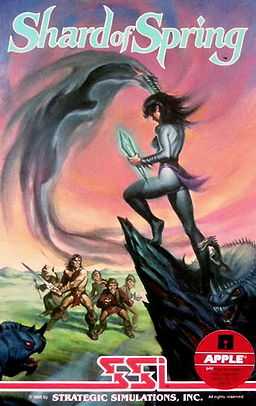Shard of Spring
| Shard of Spring | |
|---|---|
 Cover art by Joe Chiodo[1] | |
| Developer(s) | TX Digital Illusions |
| Publisher(s) | Strategic Simulations, Inc. |
| Designer(s) | Craig Roth David Stark |
| Platform(s) | Apple II, Commodore 64, DOS |
| Release date(s) | 1986[2] |
| Genre(s) | Role-playing video game |
| Mode(s) | Single player |
Shard of Spring is a role-playing video game developed and published by Strategic Simulations, Inc. for the Apple II, Commodore 64 and PC DOS computers in 1986. Shard of Spring tells the story of a group of adventurers hired to rid the world of an evil sorceress and to retrieve the titular magical item. The game was generally very well received upon its release and was followed by a sequel titled Demon's Winter in 1988.
Gameplay
The player's party in Shard of Spring can be made up of at least two human, dwarf, elf, troll or gnome adventurers, each of whom can be either a warrior or a wizard.[3] The spells are based on five elements: fire, metal, wind, ice and spirit. The game was designed to last between 40-80 hours of play.[4]
Plot
For two centuries a small island of Ymros enjoyed eternal springtime thanks to the enchanted Shard of Spring, a piece of the long-lost legendary Life Stone. However, three years ago the land's peace was shattered when a mysterious evil sorceress named Siriadne arrived to Ymros and captured the Shard. With the threat of the Shard's destruction, Siriadne and her allies now extort a ruinous and ever-increasing tribute from the people of Ymros. Anyone who might put an end to her tyranny will be a hero for all time to come. The aim of the game is to gain access to Siriadne's castle (which is encircled by a magical force field) and defeat her.[5]
The players first need to kill Siriadne's allies Ralith (in Ralith's Tower) and Edrin (in Edrin's Dungeon) so they can storm Siriadne's Fortress. Siriadne herself transforms into a dragon for the final battle. After the player's victory, the game ends in a cryptic way.[6]
Reception
| Reception | ||||||||||||||||||||||||||||||||||||||||||||||||||||||||||||
|---|---|---|---|---|---|---|---|---|---|---|---|---|---|---|---|---|---|---|---|---|---|---|---|---|---|---|---|---|---|---|---|---|---|---|---|---|---|---|---|---|---|---|---|---|---|---|---|---|---|---|---|---|---|---|---|---|---|---|---|---|
| ||||||||||||||||||||||||||||||||||||||||||||||||||||||||||||
The game was well received upon its release. According to QuestBusters, "anyone completely burned out on the 'seek and slay' scenario should look elsewhere," but "Phantasie fans who found Wizard's Crown too complex will appreciate this one, which combines the best elements of each - easily making it SSI's best game since the original Phantasie."[5]
Scorpia of Computer Gaming World gave the game a positive review, noting it as a good hack and slash type. The graphics were considered well-done, even in monochrome, but the reviewer felt leveling in the later part of the game went far too slowly.[3] On the other hand, Philippa Irving in Zzap!64 criticized the game's "lacklustre" presentation (55%) and "dull" graphics 65%, but gave the game overall rating of 88%, "just short of brilliant", for its "absorbing, tantalizing, and satisfying" playability.[8]
The game, however, did not became a classic. In 1987, Mark Patters of Commodore User gave Shard of Spring a relatively rating of 6/10.[9] Reviewers often compared this game to Ultima III: Exodus. According to a critical retrospective review by John Gorenfeld in Allgame, "unlike Wizard's Crown, SSI's RPG Shard of Spring has none of the company's characteristic war game detail. In fact, it feels like a low-rent version of Ultima III, with the latter's simple tactical combat, but less atmosphere."[7]
Sequel
A follow-up to Shard of Spring was created by the same team and published by SSI in 1988. The sequel has Ymros once again threatened by evil as the players must search for spells to defeat the demon-god Malifon who has cast the world into a deep freeze. It expanded on the first game in some ways such as offering more character classes.[10]
References and notes
- ↑ "Computer Game Museum - Loubet Tower (Art Gallery)". Mocagh.org. Retrieved 2013-07-28.
- ↑ Barton, Matt (2007-02-23). "Part 2: The Golden Age (1985-1993)". The History of Computer Role-Playing Games. Gamasutra. Retrieved 2009-03-26.
- ↑ 3.0 3.1 Scorpia (Dec 1986), "Shard of Spring", Computer Gaming World: 38–41
- ↑ Ahoy! Magazine October 1986 - Commodore Computers
- ↑ 5.0 5.1 QuestBusters - Museum of Computer Adventure Game History
- ↑ "(...) As you turn to go back into the room, you see a black bird out of the corner of your eye, moving swiftly upward. As you re-enter the room, an old man who you recognize is standing near the dead body of Siriadne. His face shows a mixture of serenity and contentment. He speaks: 'The true springtime shall now return to Ymros because of what you have done today. Your names shall be remembered as long as men exist to sing of you." He makes some mysterious motions and everything begins to swirl about you. His voice speaks to you out of the dizziness: "Evil is personified in the form of dragons, but borne in the hearts of men...'"
- ↑ 7.0 7.1 Gorenfeld, John (2010-10-03). "Shard of Spring". allgame. Retrieved 2013-07-28.
- ↑ Philippa Irving (Sep 1987), "Shard of Spring", Zzap!64: 55
- ↑ Mark Patters (Apr 1987), "Shard of Spring", Commodore User: 32
- ↑ Run 69 (September 1989)